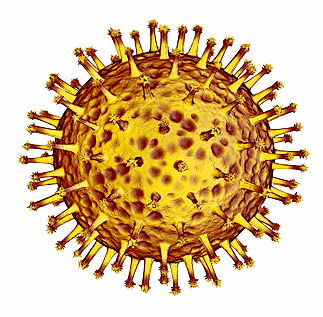Popular Articles
- Capisette Supplement Facts
- 10 Remedies for Swollen Feet and Ankles
- Listol Supplement Facts
- 9 ADHD Products Reviewed
- Water and Fluid Retention in Legs
- Edema Foods To Avoid
- 5 Products to Reduce Water Retention
- (OTC) Over the Counter Diuretics for Edema
- Get Rid of Water Retention - 17 Treatments!
- Thyax Supplement Facts
 Everything You Must Know to Prevent InfluenzaIn This Article
Influenza is driven by a set of rapidly evolving viruses. It is a dangerous respiratory disease with seasonal occurrence but that can also strike as a pandemic. Read on to find out all you need to know about influenza. Know the symptoms and the viruses. Do not wait to get the flu but prepare for the flu season with these steps.
Seasonal and Pandemic FluFlu is the common name given to influenza, a seasonal respiratory disease. Although influenza may present symptoms similar to common cold and pneumonia, it is a quite different disease. Influenza is an infectious disease that affects only birds and mammals. It is caused by RNA viruses in the Orthomyxoviridae family. These viruses are usually transmitted through the air but influenza can also be contracted by contact with infected surfaces.
Each flu pandemic is usually triggered by a new strain of the influenza virus. So far in this century, there have been 3 flu pandemics and each of them affected and killed more people than those who died during the yearly seasonal flu sessions. A pandemic flu usually happens when an animal (usually birds and pig) strain of the influenza virus crosses over and becomes infectious to humans. Alternatively, the usual influenza virus may acquire genes from one or more animal strains of the influenza virus. When these happen, the current influenza vaccine is useless and cannot stop the spread of the new virus or the severity of the resulting flu. Symptoms of InfluenzaMost cases of flu are mild but the disease can turn severe and even lethal. Children, the elderly and people with certain prevailing diseases are the ones most likely to have pretty bad flu attacks. However, not everyone who contacts influenza presents with symptoms. In fact, about one-third of those affected do not develop symptoms of the disease. Those who do develop flu symptoms see them quickly, often between 1 – 3 days after the time of infection. Most people experience chills and fever first.
Influenza shares symptoms with common cold especially at the early stages of both diseases. However, flu can be distinguished from the sudden onset of fever and fatigue. The combination of fever, cough, nasal congestion and sore throat is the definitive presentation of classic flu. Influenza Viruses
Influenza A virus is the most virulent of the influenza viruses that affect humans. Although its natural hosts are wild waterfowls, it can cross to domestic birds and even humans. H1N2 is one subtype of this virus family and it is found in humans, birds, and pigs. Influenza A virus is responsible for a number of pandemic cases of flu in human history including the 2004 Bird Flu and 2009 Swine Flu. Influenza B virus mostly infects humans but ferrets and seals may also catch it. However, it is less common and less virulent than the influenza A virus. Besides, it mutates slower than the A virus and so can be vaccinated against more easily. With these limitations in host and mutation rate, there has been no record of pandemic flu caused by influenza B virus. Influenza C virus, on the other hand, can cause local epidemics. It affects humans, dogs, and pigs. Still, it is not as common as the other 2 types. Influenza C virus can cause mild flu in children. How to Survival the Flu SeasonFlu sets off pretty fast. Even before symptoms appear, people infected with the virus can pass it on to others. Since the flu virus is transmitted by air, prevention needs to start early even before the carrier becomes sick. In addition, because of this mode of transmission, one carrier can infect quite a lot of people at home, in the workplace and everywhere he goes. Flu is most contagious in the early stages and up to 7 days after symptoms develop. In people with weakened immune systems, it may even be contagious well after the disease has passed. To avoid contracting influenza, here are the most important steps to take. Adopt Good Health HabitsAvoid Close Contact with Sick People Flu spreads mostly by proximity. In every case, those who get sick get the virus from those who are already sick. Avoiding close contact is not a sure-fire method since some of those who are sick with flu do not show symptoms, and some do not present with symptoms early enough even though they can infect others early on. In addition to avoiding contact with the sick, make sure to keep surfaces clean by wiping with disinfectants. Watch Your Hands
Besides washing your hands, avoid touching your face with your hands. The flu virus can easily cross over through the eyes, mouth, and nose. Therefore, contaminated hands can spread the virus quickly. Furthermore, do not bite your nails or share things you put to your lips such as drinks. Protect Others if You are Sick It is very easy to spread the flu virus to other people. Therefore, avoid direct contact with others if you are sick. Stay at home to limit the number of people you can spread the virus to, and also cover your mouth and nose with a tissue when sneezing or coughing. In addition, do not spread the virus by spitting. Get Your Seasonal Flu ShotsThe Center for Disease Control and Prevention (CDC) recommends getting your yearly flu shots to avoid getting sick from the influenza virus. Flu vaccines are better at controlling influenza than any good health habit you may adopt. However, even the best flu vaccines do not provide 100% protection. This is because the flu vaccine for each year are designed to protect against the 3 influenza viruses that experts believe will be most common for that flu season. Currently, flu shots protect against H1N1, H3N2 (both influenza A viruses) and influenza B virus. Since influenza viruses are always mutating, there is no way to make a vaccine to protect against them all or all the strains available. Therefore, the choice of protecting against a set of 3 viruses is as good as it gets with vaccines. Who Must Get the Yearly Flu Vaccine and Who Must Not
In the northern hemisphere, the flu season extends from November to April while in the southern hemisphere, it covers May to October. There is no flu season in the tropics, therefore, the disease can occur at any time. Flu vaccines should be taken at least 2 weeks before the season since that this is the length of time it takes for the vaccine to mount full protection and prompt the production of antibodies. It is estimated that flu vaccines are effective in 50 – 80% of cases. However, even when the vaccine does not stop influenza, those who are vaccinated usually have a mild form of flu which resolves quicker than in those who do not vaccinate. While the flu vaccination is recommended for everyone, there are specific groups of people who must get flu shots because they are most at risk of contracting influenza. Such people include:
While flu vaccination is highly recommended to protect against influenza, there are some people for whom flu shots are not recommended. Those who should not be vaccinated include:
Complications may arise even for people for whom flu vaccines are recommended. Those who are most at risk of developing complications after receiving flu vaccines include:
Types of Flu Vaccines
The regular form of the flu vaccine is the flu shot, a vaccine injected into the muscles. The intramuscular flu vaccine is recommended for adults and children who are older than 6 months. A variation of the classic intramuscular flu vaccine is the hi-dose vaccine that was introduced in 2010 and recommended for adults aged 65 years and older. The intradermal flu vaccine was introduced in 2011. It employs a thinner needle and delivers a smaller vaccine load. It is recommended for adults aged 18 - 64 years. While both the intramuscular and intradermal flu vaccines are made from killed influenza viruses, the third form of flu vaccine, nasal spray vaccine, is made from weakened but live flu viruses. Therefore, this vaccine is also called LAIV or live attenuated influenza virus. Although the nasal spray flu vaccine contains live viruses, they are weakened and only trigger the production of antibodies and not full-blown flu. Still, this form of flu vaccines is not recommended for pregnant women and those with a weakened immune system. Rather, the nasal spray flu vaccine is recommended for anyone aged 2 – 49 years. Take Antiviral MedicationsAlthough antiviral medications are not so much a means to prevent influenza as a means to treat the disease, they can still be helpful as a preventative method. Antiviral medications are recommended after exposure to carriers of the influenza virus. Therefore, those who have close, prolonged contacts with people sick with flu should take these drugs to avoid catching the virus. Antiviral drugs for flu are most effective the earlier they are taken. When taken before the first symptoms, they can completely stop influenza. These drugs are also important for preventing flu in people who cannot receive the vaccine but who may be exposed to the virus. Therefore, antiviral flu drugs are given to people aged 65 years and older as well as those who have underlying medical conditions that may leave them open to complications of the disease. In addition, where there is a sudden outbreak of flu before the start of the flu season and before vaccines are given, antiviral medications are the only option for stopping the spread of influenza. Examples of antiviral drugs recommended for preventing influenza are oseltamivir (Tamiflu), zanamivir (Relenza), amantadine and rimantadine. However, antiviral drugs are only recommended for preventing influenza where vaccination is late or cannot be given. The indiscriminate use of antiviral drugs for preventing and treating influenza has given rise to drug resistance. Given the severity and rapid spread of influenza viruses during epidemics, the use of antiviral drugs is being discouraged for combating influenza unless they are absolutely necessary. Sourceshttp://www.mayoclinic.com/health/influenza/DS00081/DSECTION=prevention http://www.thirdage.com/hc/c/seasonal-influenza-prevention http://www.cdc.gov/flu/protect/preventing.htm
[+] Show All
|
||





 The rate of influenza infections usually changes with the seasons. Seasonal flu affects about 5 million people globally every year and kills about 10% of those affected. However, beyond the seasonal fluctuation of influenza, there are years with a flu pandemic.
The rate of influenza infections usually changes with the seasons. Seasonal flu affects about 5 million people globally every year and kills about 10% of those affected. However, beyond the seasonal fluctuation of influenza, there are years with a flu pandemic. Of the five sub-types of viruses in the Orthomyxoviridae family, three of them are influenza viruses. These are influenza viruses A, B, and C.
Of the five sub-types of viruses in the Orthomyxoviridae family, three of them are influenza viruses. These are influenza viruses A, B, and C. Because the influenza virus can also spread by touching infected surfaces, make sure to clean your hands especially when using shared, public spaces. To clean your hands, use soap and water. Alternatively, you can use an alcohol-based hand rub.
Because the influenza virus can also spread by touching infected surfaces, make sure to clean your hands especially when using shared, public spaces. To clean your hands, use soap and water. Alternatively, you can use an alcohol-based hand rub. Flu vaccination is important before the start of the flu season.
Flu vaccination is important before the start of the flu season. The flu vaccine is available in 3 forms: an intradermal injection, an intramuscular injection and a nasal spray.
The flu vaccine is available in 3 forms: an intradermal injection, an intramuscular injection and a nasal spray.